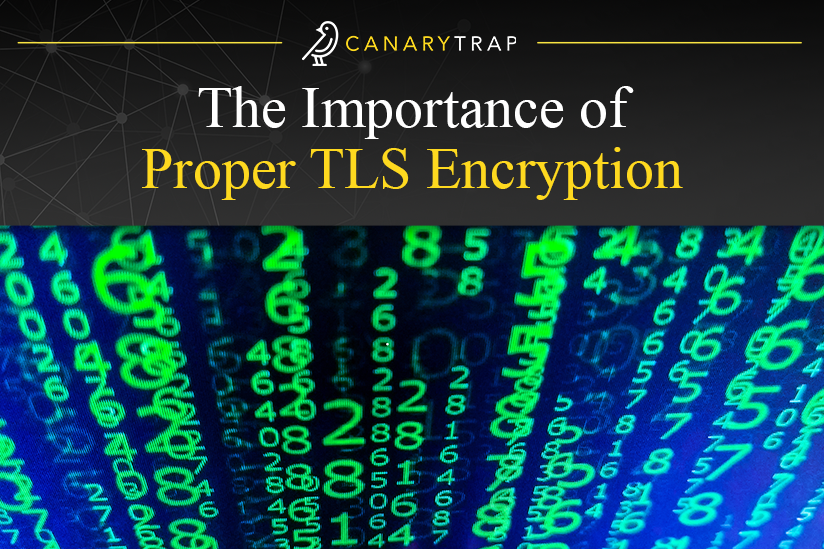The Importance of Proper TLS Encryption
- September 8, 2023
- Canary Trap
In an era marked by rapid technological advancements and increasing digital interactions, the need for robust cybersecurity measures has never been more pronounced. Among the foundational pillars of online security, Transport Layer Security (TLS) encryption stands as a crucial safeguard for sensitive data and secure communications. From protecting personal information to preventing cyberattacks, the proper implementation of TLS encryption plays an essential role in maintaining trust and ensuring the integrity of online interactions. This article delves into the importance of proper TLS encryption, highlighting its significance in safeguarding data privacy, preventing cyber threats, enhancing user trust, and ultimately, fortifying the digital ecosystem against emerging vulnerabilities.
Implementing Proper TLS Encryption
Before properly encrypting TLS, there are several important steps and considerations that need to be addressed to ensure a successful implementation. These preliminary actions set the foundation for effective TLS encryption and secure communications:
- Environment Assessment. Conduct a comprehensive assessment of your IT infrastructure, applications, and communication channels. Identify critical assets, sensitive data, and potential vulnerabilities. Understanding your environment’s intricacies will guide your TLS encryption strategy and help you prioritize protection where it’s most needed.
- Encryption Objectives. Clearly define the goals and objectives of implementing TLS encryption. Determine what types of data need protection, such as personal information, financial data, login credentials, and sensitive communications. Additionally, establish the level of encryption required based on industry standards and compliance regulations.
- Certificate Authority (CA). Select a reputable and trusted Certificate Authority (CA) to obtain digital certificates for your servers. CAs validate the authenticity of your domain and ensure secure connections. Research different CAs, their offerings, and customer reviews to make an informed decision. According to the SSL/TLS Guide for Best Practices 2023, “All publicly trusted CAs are subject to rigorous third-party audits to maintain their position in major operating system and browser root certificate programs, but some are better at maintaining that status than others.”
- Certificate Installation. Obtain the necessary SSL/TLS certificates for your domains and servers. This involves generating a Certificate Signing Request (CSR), submitting it to the chosen CA, and installing the issued certificates on your servers. Properly configuring the certificates is crucial for seamless encryption. As mentioned in the SSL/TLS Guide, “End-entity SSL/TLS certificates are generally signed by intermediate certificates rather than a CA’s root key. Make sure that any intermediate certificates are installed on your web server to provide browsers with a complete certification path and avoid trust warnings and errors for end users.”
- Server Settings. Configure your web server settings to enable TLS encryption. This includes configuring SSL/TLS protocols and cipher suites to ensure compatibility with a wide range of devices and browsers. Consider disabling outdated protocols like SSLv3 and weak cipher suites to enhance security.
- Website HTTPS. Implement HTTPS for your website by configuring your web server to use TLS encryption. This involves updating URLs, configuring redirects, and ensuring that all resources (images, scripts, stylesheets) are loaded securely over HTTPS. As mentioned in an article published by The SSL Store, HTTPS is “the de facto standard protocol for secure communication on the world wide web — it’s been chosen as the most secure option by the stakeholders that help run the web.”
- Implementation Verification. Thoroughly test your TLS implementation to ensure proper functionality and security. Use online SSL/TLS testing tools to identify any configuration issues, vulnerabilities, or weaknesses. Regularly monitor and audit your TLS settings to address potential issues promptly.
- Security Headers. Deploy security headers like HTTP Strict Transport Security (HSTS) and Content Security Policy (CSP) to enhance the security of your web application. HSTS enforces HTTPS connections, while CSP mitigates risks associated with cross-site scripting (XSS) and content injection attacks.
- Documentation & Communications. Update your documentation, support materials, and communication channels to inform users and stakeholders about the transition to HTTPS and TLS encryption. Communicate the benefits of secure connections to your users and educate them about the visual indicators of a secure website.
- Monitoring and Maintenance. Implement monitoring and alerting mechanisms to stay informed about potential security incidents, certificate expirations, and configuration changes. Regularly update SSL/TLS certificates, renew them before they expire, and stay up to date with industry best practices and security updates.
By addressing these preliminary steps, you’ll be well-prepared to embark on a successful TLS encryption journey, enhancing the security of your digital interactions and building trust among users and stakeholders.
Implementing Proper TLS Encryption
As we know by now, successful TLS encryption implementation involves a combination of technical measures, careful planning, and adherence to best practices. Here are some key elements that also contribute to a successful TLS encryption:
Choosing the Right Cipher Suites
Cipher suites are combinations of encryption algorithms and cryptographic tools that determine how TLS will secure a connection. That’s why selecting the right cipher suites is paramount for a robust TLS Encryption. As explained by Key Factor, “To initiate an HTTPS connection, the two parties – the web server and the client – perform an SSL handshake. The handshake process is a fairly complicated one, during which the two parties agree on a mutual cipher suite. The cipher suite is then used to negotiate a secure HTTPS connection.”
- Understanding Cipher Suites. A cipher suite comprises key exchange algorithms, encryption algorithms, and message authentication codes (MACs). Understanding these components helps in making informed choices.
- Prioritizing Strong Algorithms. Opt for modern, robust algorithms such as ECDHE for key exchange and AES for encryption. Avoid deprecated algorithms like RC4, which are known to have vulnerabilities.
- Compatibility Considerations. Balance security with compatibility. While using the latest algorithms ensures maximum security, compatibility with older systems may necessitate some compromises.
Configuration and Best Practices
Proper TLS encryption isn’t only about choosing the right tools; it’s about configuring them correctly. Organizations should follow best practices in order to avoid common mistakes:
- Enforcing Strong Protocols. Disable older, insecure protocols like SSL and early TLS versions. Enforce the use of modern versions like TLS 1.3.
- Using Forward Secrecy. Implement protocols that support forward secrecy, ensuring that if a key is compromised, it cannot be used to decrypt past sessions.
- HTTP Strict Transport Security (HSTS). Implement HSTS to ensure that browsers only connect to the server using a secure connection, preventing downgrade attacks.
- Regular Security Assessments. Conduct periodic security assessments, such as penetration testing or vulnerability scanning, to identify and fix potential weaknesses in the TLS configuration.
Challenges of Implementing TLS Encryption
In an article discussing some of the challenges that TLS encryption might present, the DevOps Resource Center at Trend Micro explained that “When using TLS, there’s a good chance that the information sent through the connection is not inspected or monitored at the endpoint. This is because TLS uses encryption algorithms to scramble data in transit, so it’s assumed to be secure; however, hackers can take advantage of this. Because everyone thinks they are secure enough, hackers on the other end can exploit various vulnerabilities in TLS to listen to the traffic (which can lead to financial and business loss) and even drop malware.”
Overcoming the challenges of TLS encryption involves a combination of strategic planning, technical solutions, and continuous vigilance. Here are some challenges that organizations need to address:
- Performance Considerations. While encryption adds a layer of security, it may also add latency. Optimizing configurations, employing modern algorithms, and using hardware acceleration can mitigate performance issues.
- Managing Multiple Certificates. In complex environments with multiple domains or services, certificate management can become cumbersome. Tools and policies that centralize certificate management can simplify this task.
- Education and Training. Ensuring that the staff responsible for implementing and maintaining TLS encryption have the necessary skills and knowledge is critical. Ongoing training and support from experts can make a significant difference.
Common Pitfalls and How to Avoid Them
Outdated Protocols
Utilizing outdated or deprecated TLS protocols can introduce significant vulnerabilities. SSL and older TLS versions contain known weaknesses, which is why it’s always best to update to the latest supported version (in this case, TLS 1.3). Outdated protocols should be disabled to ensure only secure versions are in use.
Improper Configuration
Misconfiguration is a common issue that can render even the most robust TLS encryption ineffective. Incorrectly configured cipher suites, errors in certificate setup and failure to implement forward secrecy can lead to vulnerabilities. Therefore, adhering to best practices for TLS configuration, using automated assessment tools and engaging with cybersecurity experts is key to ensure optimal configuration.
Weak Cipher Suites
Weak or compromised cipher suites can undermine the entire security structure. Some of them are no longer considered secure and can be exploited by determined attackers. That’s why choosing the right cipher suites is so important. Experts should keep up to date with the latest developments in cryptography and maintain an updated list of approved cipher suites.
Lack of Monitoring and Maintenance
Continuous monitoring and regular maintenance are vital to the ongoing security of a TLS implementation. That’s why it’s necessary to implement monitoring tools that can automatically check for expiring certificates, misconfigurations, and other potential issues. Regularly reviewing configurations and updating them according to the latest best practices is also important.
Ignoring Performance Impact
Securing communication with TLS does introduce some computational overhead, which can affect performance. Without careful planning and optimization, TLS encryption can slow down connections and impact user experience. In order to minimize latency, organizations should monitor performance and use techniques like TLS session resumption and optimized cipher suites. They should also consider hardware acceleration if necessary.
Lack of Internal Education
The human factor is often the weakest link in the security chain. Without proper understanding and training, staff may unintentionally undermine security through errors in configuration, management, or response to incidents. Regular training and awareness programs can empower staff to handle TLS effectively. This includes not only technical staff but also management and others who may be involved in decision-making related to TLS.
In Conclusion
The landscape of TLS encryption is multifaceted, and the understanding of its depth and breadth requires dedication. To understand the importance of proper TLS encryption, it’s important to analyze effective ways of implementing and managing it to safeguard sensitive information from cyber attacks.
In order to avoid some of the challenges that TLS encryption might present, organizations need to stay abreast of the latest developments to foster a culture of continuous learning and professional development to empower individuals to navigate the complexities of TLS encryption with expertise and contribute to a safer digital environment.
SOURCES:
- https://www.ssl.com/guide/ssl-best-practices/
- https://www.thesslstore.com/blog/is-https-secure-a-look-at-how-secure-https-is/
- https://www.keyfactor.com/blog/cipher-suites-explained/
- https://www.trendmicro.com/en_fi/devops/23/a/tls-connection-cryptographic-protocol-vulnerabilities.html

